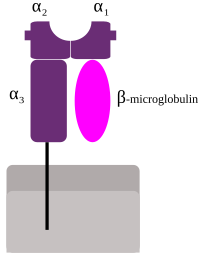
Photo from wikipedia
BACKGROUND AND AIMS No report explored the combined effects of HLA-DPA1 and -DPB1 with long-term response to hepatitis B (HB) vaccination (HBVac). The specific aims of the study were to… Click to show full abstract
BACKGROUND AND AIMS No report explored the combined effects of HLA-DPA1 and -DPB1 with long-term response to hepatitis B (HB) vaccination (HBVac). The specific aims of the study were to assess the combined effects and relative contributions of DPA1 and DPB1 genes. METHODS The cases were 152 adolescents who had undetectable (<1.0 mIU/mL) post-booster anti-HBs titers and the controls were adolescents who had residual anti-HBs ≥ 10 mIU/mL at aged 16 years (n = 207) or had detectable (≥1.0 mIU/mL) anti-HBs titers after booster HBVac (n = 481). HLA-DPA1 and -DPB1 genotypes were determined by sequence-based typing. RESULTS HLA-DPA1*01:03:01 was correlated with lower ORs of undetectable anti-HBs titers, while -DPA1*02:02:02 and -DPB1*05:01:01 were correlated with higher ORs. The ORs for HLA-DPA1*01:03:01-DPB1*05:01:01 and DPA1*02:02:02-DPB1*protective combinatory types were significantly less than 1.0. As compared with subjects who had no protective allele, the adjusted ORs (95% CI) were 0.545 (0.328-0.906), 0.350 (0.174-0.702), and 0.122 (0.058-0.257), for subjects who had protective alleles on DPA1only, DPB1 only, and both genes, respectively. Analyses of amino acid polymorphisms showed that subjects who carried Arg81-Pro158-Val191-Pro259α + Met234β and Gln62-Arg82α + Met234β combinations had 4.3-to-4.6 folds of risks. CONCLUSION Both DPA1 and DPB1 genes contribute to the persistence of immunological response to primary infantile HBVac. The effects of HLA-DP risk alleles were dominated by the protective alleles and there were significant gene-gene interactions. Our findings provide evidences for the design of more potent HB vaccine.
Journal Title: Vaccine
Year Published: 2019
Link to full text (if available)
Share on Social Media: Sign Up to like & get
recommendations!